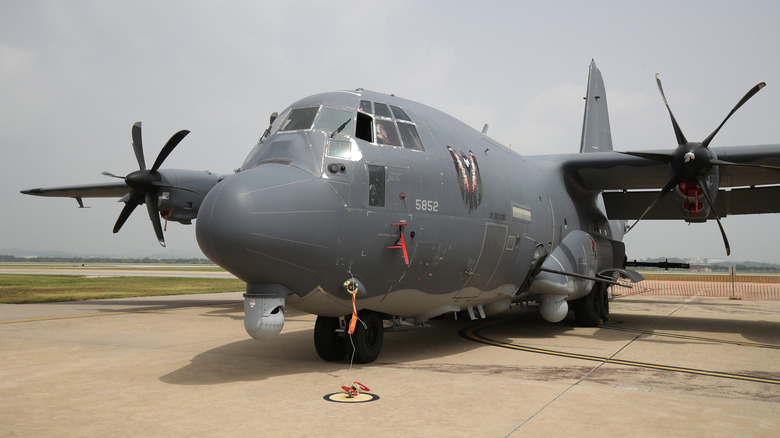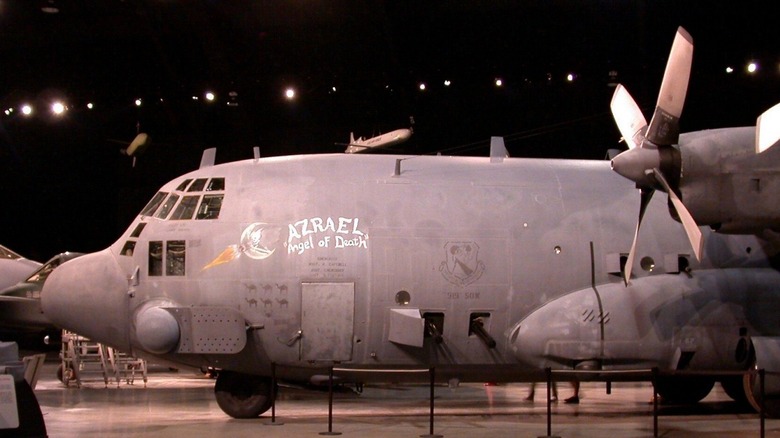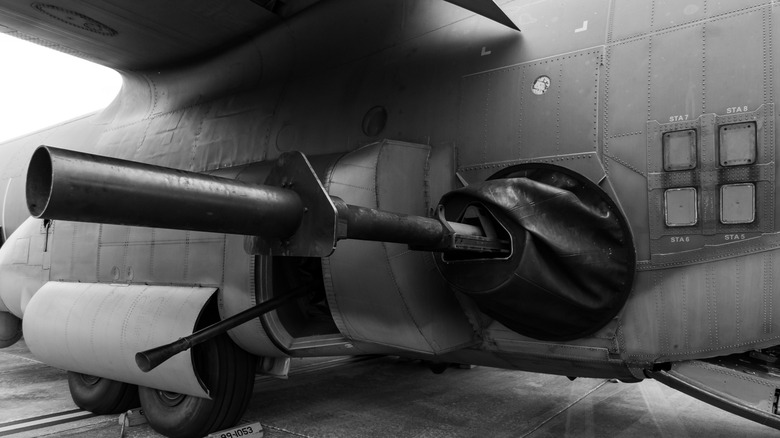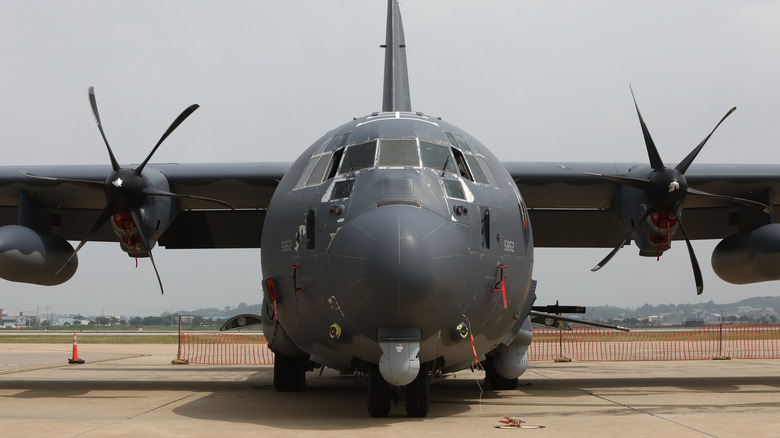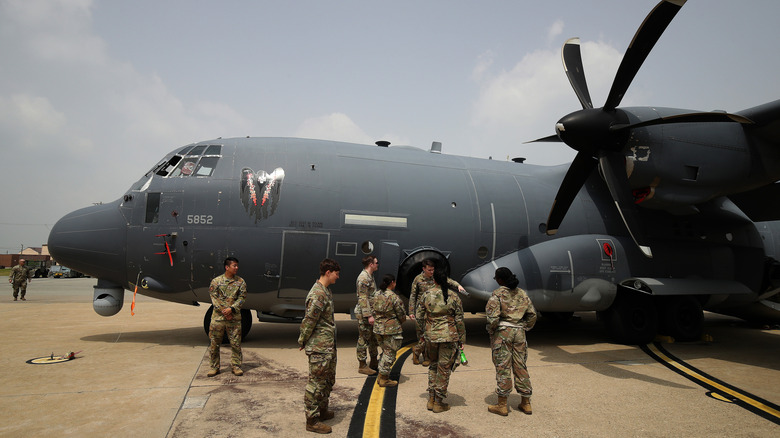Why Is The US Military's AC-130 Gunship Called 'The Angel Of Death'?
During the Vietnam War, the United States Air Force's first gunship, the AC-47, was introduced. It was primarily created to be able to unleash steady, accurate, and constant streams of fire on ground targets in terrain that was very challenging for aircraft. To that end, it was a fixed-wing design and was equipped with hefty miniguns, 7.6 millimeter models, that could fire 100 rounds every second. Its call sign was Spooky, and it was referred to as Puff the Magic Dragon for the fury it could unleash during nighttime attacks. The AC-47's successful role in warfare led to the development of further gunships that built on the concept, one of the most prominent of which being the monstrous AC-130.
The AC-130 first appeared later in the conflict and was an adaptation of the C-130 Hercules, a hefty military cargo aircraft with a big capacity. In this configuration, C for Cargo translated to AC for Attack-Cargo, which meant ample room for a great variety of weaponry and the associated munitions.
The AC-130 was heavily armed and was designed to not only carry a wide arsenal but also to be able to make the most effective use of it. Even more imposing than its Spooky predecessor, and several times as deadly, it came to be known as the Angel of Death. Let's review the arsenals of the AC-130 family variants to see just how justified this moniker is.
The initial model of the AC-130 was a force to be reckoned with from the start
The AC-130 was first converted from a cargo heavyweight to a powerhouse of a gunship by North American Rockwell in 1987. Its origins took a toll in terms of its agility, one of the major weaknesses of the AC-130. The initial model was the AC-130A, which could weigh up to 124,200 pounds when fully laden, and was capable of speeds of up to 480 mph. At almost 97 feet long and with a wingspan of 132 feet, 7 inches, it was a formidable presence on any battlefield. Its weaponry consisted of a quartet of cannons in two different sizes and dual 7.62 miniguns.
The issue with such an arsenal, though, is that it lacks range, and an aircraft with the sheer size of the AC-130 family could be incredibly vulnerable when flying low and predictable to get the best use of its guns. For this reason, it would typically be employed after dark, locating its targets by means of a sophisticated Low Light Level Television Sensor.
The National Museum of the United States Air Force boasts an example of the first variant of this fearsome aircraft, a specific plane that was nicknamed Azrael after the Islamic angel of death. The impressive and terrifying thing is that the AC-130 family would just become more potent as time went on.
Later AC-130 variants' extraordinary firepower and capabilities
The key to the lethality of a model like the AC-130 is ensuring that its weaponry is kept up to date. In order to facilitate this, further members of the family would be introduced as time went on. The AC-130H, which was fielded just a few years later in the early 1970s, had been equipped with more power, both in the engine department — in the form of four Allison T56-A-15 turboprops – and in the crucial area of its weaponry. The H variant was armed with higher-caliber guns consisting of 40 millimeter and 105 millimeter cannons. It was followed, in turn, by the AC-130U, similarly armed with the 105 millimeter howitzer to back up its 25 millimeter and 40 millimeter armaments.
Improvements were not solely restricted to firepower, but survivability and utility too. For instance, the AC-130U had a much higher operational ceiling than its predecessor, thanks to the addition of pressurization in the cabin. First and foremost, though, the family has been a prominent and fearsome gunship for all of its long history. At a ceremony to mark the end of service of the last AC-130U in 2015, the Cannon Air Force Base reported that 16th Special Operations Squadron Captain Aaron Magger declared, "As the AC-130H chapter of gunship evolution comes to a close, the AC-130H is the single deadliest aircraft and flying squadron in the war on terrorism." However, the final models of the AC-130 would be equipped with even more powerful weaponry.
Just how powerful did the Angel of Death become?
By July 2019, the AC-130 had become the Ghostrider, the call sign for the J variant. It could be equipped with a remarkable suite of weaponry, depending on what its mission called for. A Standoff Precision Guided Munitions package offered AGM-176 Griffin and AGM-114 Hellfire missiles, as well as GBU-39 Small Diameter Bombs. The missiles each lend something unique to the gunship's capacities. While the Hellfire is enormously effective against opposing ground armor, such as tanks and fortifications, Griffin missiles are best employed against lighter targets. They are designed to limit the risk caused to nearby friendlies on the battlefield.
It's clear to see why this new arsenal was such a valuable addition to the gunship. It wouldn't want to be the Angel of Death for allies and friendlies, after all, so clearing opposing heavy armor and delivering as much firepower as possible while reducing the risk to them only makes the aircraft even more potent.
It has, in short, come to be known as the Angel of Death for its tremendous and varied firepower. The epitome of its strength, perhaps, is the monstrous howitzer that generations of AC-130s have wielded. This 105 millimeter weapon is, per CNN, "the biggest gun ever mounted on a fixed-wing plane." The recoil from its vast shots — each weighing 43 pounds — is, according to the outlet, "so powerful that it pushed the tail of the 80-ton plane six feet to the right."
The operational history of the AC-130
The strength of the gunship is defined by Major Josh Burris, who told CNN, "The unique thing about the AC-130 is the amount of fire that we bring, the amount of munitions...and the amount of loiter time we can provide." The Smithsonian Channel's Air Warriors series deemed it "the world's biggest flying artillery gun. Its enemies know it as Hell in the Sky."
It's bristling with weaponry, but its reputation as the Angel of Death is based on more than that. It's a guardian angel of sorts for its allies, with USAF Lieutenant General Michael Conley boasting to The War Zone in September 2024, "what the gunship's known for...with our ground partners, is just the sound of freedom overhead and knowing that someone's there watching them."
It has played a vital role in several conflicts. In the Vietnam War, AC-103s were pivotal in defending South Vietnamese allies and destroying opposing heavy armor. During the 1980s, Operations Urgent Fury and Just Cause used the AC-103s for air support and precision attacks on key targets, and they'd continue with this invaluable role into 2004 — when they were a crucial part of the U.S. claiming of Fallujah – and beyond. The AC-130J Ghostrider remains in service, but its place in conflicts of the future has considerable question marks around it. Nonetheless, it has certainly proven itself as a worthy Angel of Death. A true propeller-driven icon of the U.S. Air Force.
